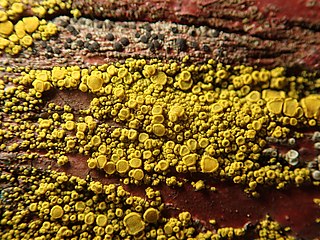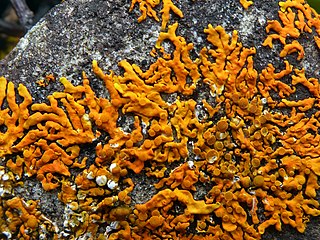
Cladonia rangiferina, also known as reindeer cup lichen, reindeer lichen or grey reindeer lichen, is a light-colored fruticose, cup lichen species in the family Cladoniaceae. It grows in both hot and cold climates in well-drained, open environments. Found primarily in areas of alpine tundra, it is extremely cold-hardy.
Lake Waikareiti, also spelt Lake Waikare Iti, is located in Te Urewera National Park in the North Island of New Zealand. A number of hiking trails are found within the catchment basin of the lake.
A fenestra is any small opening or pore, commonly used as a term in the biological sciences. It is the Latin word for "window", and is used in various fields to describe a pore in an anatomical structure.

Sauna Open Air Metal Festival, shortly Sauna Open Air or just Sauna, was one of the largest music festivals dedicated only to heavy metal and related styles of rock music in the Nordic countries. It was first arranged in 2004 and takes place in the Ratinanniemi park in Tampere, Finland. From 8 June to 10 June 2006, over 20,000 people arrived to watch such bands as Cradle of Filth, Finntroll, Iggy & The Stooges, Lordi, Twisted Sister and W.A.S.P.

The flora of the Faroe Islands consists of over 400 different plant species. Most of the lowland area is grassland and some is heather, mainly Calluna vulgaris. The Faroese nature is characterized by the lack of trees and resembles that of Connemara and Dingle in Ireland.

Saxidomus nuttalli is a species of large edible saltwater clam, a marine bivalve mollusk in the family Veneridae, the venus clams. Common names include California butterclam and Washington clam.

Sceloporus occidentalis occidentalis is a subspecies of the western fence lizard. The common name for this taxon is the northwestern fence lizard. This lizard occurs in the state of Washington in the United States.

Bacillariaceae is a family of diatoms in the phylum Heterokontophyta, the only family in the order Bacillariales. Some species of genera such as Nitzchia are found in halophilic environments; for example, in the seasonally flooded Makgadikgadi Pans in Botswana.

Hypnaceae is a large family of moss with broad worldwide occurrence in the class Bryopsida, subclass Bryidae and order Hypnales. Genera include Hypnum, Phyllodon, and Taxiphyllum.

Ptilium crista-castrensis, the knights plume moss or ostrich-plume feathermoss, is a moss species within the family Pylaisiaceae, in the class Bryopsida, subclass Bryidae and order Hypnales.

Caloplaca saxicola is a small bright orange crustose lichen that grows on rock all over the world. It is commonly called rock firedot lichen, jewel lichen or rock jewel lichen.

Candelariella is a genus of bright yellow, ocher, or greenish yellow crustose or squamulose lichens in the family Candelariaceae. Members of the genus are commonly called eggyolk lichens, goldspeck lichens, or yolk lichens. The genus was circumscribed in 1894 by Swiss lichenologist Johannes Müller Argoviensis, with Candelariella vitellina assigned as the type species.

Acronicta insita, the large gray dagger or fingered dagger, is a moth of the family Noctuidae. The species was first described by Augustus Radcliffe Grote in 1874. It is found from Newfoundland west to the Pacific coast and Vancouver Island and Haida Gwaii, British Columbia, south to North Carolina and Colorado.

Gowardia is a genus of medium-sized, greyish hair lichens in the family Parmeliaceae. It is a circumpolar genus, mainly restricted to arctic-alpine habitats in northern Canada, Europe, and Russia.

Dactylina is a genus of lichen-forming fungi in the family Parmeliaceae. The genus was circumscribed by Finnish botanist William Nylander in 1860, with Dactylina arctica assigned as the type species.

Esslingeriana is a fungal genus in the family Parmeliaceae. The genus is monotypic, containing the single foliose lichen species Esslingeriana idahoensis, commonly known as the tinted rag lichen. It is found in northwestern North America.
John Walter Thomson Jr. (1913–2009) was a Scottish-born American botanist and lichenologist, sometimes referred to as the "Dean of North American Lichens".

Dufourea is a genus of mostly foliose lichen species in the subfamily Xanthorioideae of the family Teloschistaceae. Species in the genus are mostly found in the Southern Hemisphere.

Pulchrocladia retipora, commonly known as the coral lichen, is a species of fruticose lichen in the family Cladoniaceae. Found predominantly in Australasia, its habitats range from the Australian Capital Territory to New Zealand's North and South Islands, and even the Pacific region of New Caledonia, where it grows in coastal and alpine heathlands. The lichen features coral-like branches and subbranches with numerous intricate, netlike perforations. It is known by multiple names, with some sources referring to it by its synonym Cladia retipora, or the common name lace lichen.
















